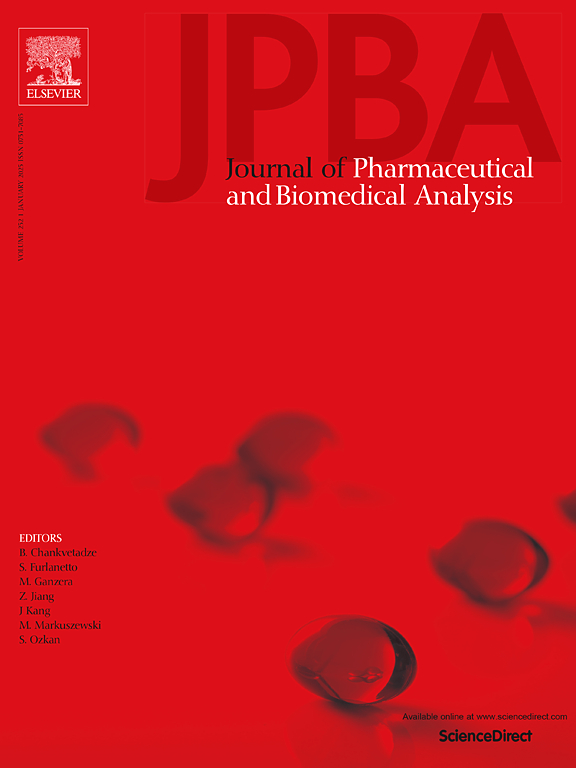脂质组学分析揭示了小鼠在禁食-再摄食过渡期肝脂质组的动态变化
IF 3.1
3区 医学
Q2 CHEMISTRY, ANALYTICAL
Journal of pharmaceutical and biomedical analysis
Pub Date : 2025-05-13
DOI:10.1016/j.jpba.2025.116966
引用次数: 0
摘要
肝脏在禁食-再摄食过渡期间维持能量稳态中起着关键作用。我们之前报道过禁食-再喂养诱导肝脏大小的动态变化。然而,在这些动态变化中肝脂质谱的变化仍不清楚。因此,本研究旨在通过脂质组学分析阐明禁食和再摄食对小鼠肝脏脂质稳态的影响,并确定在禁食-再摄食过渡期间变化的特定脂质。在本研究中,C57BL/6小鼠禁食24 h,随后分别喂饱1、3、6、12和24 h。在每个时间点采集肝脏和血清样本作进一步分析。结果表明:禁食使大鼠肝脏体积明显减小,并伴有肝脏脂质堆积,再饲喂后均恢复正常。脂质组学分析显示,共有309种脂质受到明显干扰,其中一半以上属于甘油三酯(TG)。与此一致的是,禁食显著改变了与脂肪酸摄取、TG合成和代谢相关的基因表达,这些基因在重新喂食后恢复到基线水平。综上所述,这些研究结果表明,禁食导致肝脏收缩和脂质谱的变化,特别是肝脏中TG的积累,而这些影响可以在再喂养后逆转。本文章由计算机程序翻译,如有差异,请以英文原文为准。
Lipidomic profiling reveals the dynamic changes of hepatic lipidome during the fasting-refeeding transition in mice
Liver plays a pivotal role in maintaining energy homeostasis during fasting-refeeding transition. We previously reported that fasting-refeeding induces the dynamic changes of liver size. However, the alterations in hepatic lipid profiles during these dynamic changes remain unclear. Therefore, the present study aimed to clarify the effect of fasting and refeeding on hepatic lipid homeostasis in mice using lipidomics analysis and to identify the specific lipids that vary during the fasting-refeeding transition. In this study, C57BL/6 mice were fasted for 24 h and subsequently refed for 1, 3, 6, 12, and 24 h, respectively. Liver and serum samples were collected at each time point for further analysis. The results demonstrated that fasting obviously decreased the liver size accompanying with hepatic lipid accumulation, which were all returned to normal level after refeeding. Lipidomics analysis revealed that a total of 309 lipids were significantly disturbed, over half of them belonged to triacylglycerol (TG). Consistently, fasting significantly altered the expression of genes associated with fatty acid uptake, TG synthesis and metabolism, which were returned to baseline level after refeeding. In conclusion, these findings demonstrated that fasting induced liver shrinkage and the change of lipid profiling, especially TG accumulation in liver, while these effects can be reversed after refeeding.
求助全文
通过发布文献求助,成功后即可免费获取论文全文。
去求助
来源期刊
CiteScore
6.70
自引率
5.90%
发文量
588
审稿时长
37 days
期刊介绍:
This journal is an international medium directed towards the needs of academic, clinical, government and industrial analysis by publishing original research reports and critical reviews on pharmaceutical and biomedical analysis. It covers the interdisciplinary aspects of analysis in the pharmaceutical, biomedical and clinical sciences, including developments in analytical methodology, instrumentation, computation and interpretation. Submissions on novel applications focusing on drug purity and stability studies, pharmacokinetics, therapeutic monitoring, metabolic profiling; drug-related aspects of analytical biochemistry and forensic toxicology; quality assurance in the pharmaceutical industry are also welcome.
Studies from areas of well established and poorly selective methods, such as UV-VIS spectrophotometry (including derivative and multi-wavelength measurements), basic electroanalytical (potentiometric, polarographic and voltammetric) methods, fluorimetry, flow-injection analysis, etc. are accepted for publication in exceptional cases only, if a unique and substantial advantage over presently known systems is demonstrated. The same applies to the assay of simple drug formulations by any kind of methods and the determination of drugs in biological samples based merely on spiked samples. Drug purity/stability studies should contain information on the structure elucidation of the impurities/degradants.

 求助内容:
求助内容: 应助结果提醒方式:
应助结果提醒方式:


